 Research Article
Research Article
Formulation and Evaluation of Complementary Foods for Children from Six to Twenty- Four Months Prepared from Potential Locally Available Foodstuffs In Tuba Sub-Division of Cameroon
Difo Voukang Harouna1*, Yonas Vandi1 and Nyuindebe Meme Caris2
1Department of Biological Sciences, Genetic, Genomic, Proteomics and Food for Nutrition Research Unit, Faculty of Sciences, University of Maroua, P O Box 814, Maroua, Cameroon
2Department of Food Technology, School of Home Economics, Tourism and Hospitality Management, National Polytechnic University Institute Bamenda (NPUIB), P.O. Box 1136, North- West Region, Cameroon
Difo Voukang Harouna, Department of Biological Sciences, Genetic, Genomic, Proteomics and Food for Nutrition Research Unit, Faculty of Sciences, University of Maroua, P O Box 814, Maroua, Cameroon.
Received Date:May 15, 2023; Published Date:July 21, 2023
Abstract
The present research work aimed at formulating complementary foods (weaning foods) base on the protein content of the locally used staple foods by the families in Tubah Subdivision of the North- West Region of Cameroon as well as analysing their nutritional content and sensory properties. A face-to-face interview with the help of a pre-prepared questionnaire was used to survey the locally used foodstuffs in Tubah Subdivision. The proximate composition of the various foodstuffs and the formula were carried out by the AOAC methods. The hedonic point methods were used for the sensory evaluation of the final products. Maize, Rice, Soyabeans and Irish potatoes were the main food ingredient used in the preparation of children’s food. Based on this main ingredient and their protein content, three complementary foods were formulated (F1, F2, F3). The three formulas had more nutritional properties as compared to a control (Nestle cerelac). The sensory qualities of the three formulas were above three (03) on the five (5) point hedonic scale. Therefore, the foodstuffs used in the Tubah Subdivision are good ingredient for the formulation of a good, nutritious complementary food with good qualities.
Keywords: Complementary food; Weaning food; Local staple food; Malnutrition
Introduction
Adequate nutrition during infancy and early childhood is fundamental to the development of each child full human potential. It is well recognized that the period from birth to two years of age is a critical window for the promotion of optimal growth, heath and behavioral development. Various studies has consistently shown that this is the peak age for growth faltering deficiencies of certain micronutrient; and common childhood illness such as diarrhea. After a child reaches 2years of age, it is very difficult to reverse stunting that occurred earlier. The immediate consequences of poor nutrient during these formative years include significant morbidity and mortality and delayed mental and motor development. In the long run, nutritional early deficit are linked to improvements in intellectual performance, work, capacity, reproductive outcomes and overall and health during adolescence and adulthood [1].
Complementary feeding is defined as the process when milk alone is no longer sufficient to meet the nutritional requirements of infants and therefore other foods and liquids are needed, along with breast milk. The target age for complementary feeding is generally taken to be 6 to 24months of age, even though breastfeeding may continue beyond two years [2, 3]. A review of feeding guidelines promoted by various national and international organizations has shown that there are inconsistencies in the specific recommendation for feeding infants and young [1, 2].
Poor breastfeeding and complementary feeding practices, coupled with high rates of infectious disease, are the principal proximate causes of malnutrion during the first two years of life. For this reason, it is essential to ensure that caregivers are provided with appropriate guidance regarding optimal feeding of infants and young children [4].
Some of the feeding guidelines are based more on tradition and speculation than on scientific evidence or are for prescriptive than is necessary regarding issues such as the order of foods introduced and the amounts of specific foods to be given. To avoid confusion a set of unified, scientifically based guidelines is needed, which can be adapted to local feeding practices and condition. The guidelines described herein were developed from discussions at several consultations and documents on complementary feeding [3].
Poor feeding practices as well as lack of suitable complementary foods are responsible for undernutrition with poverty exacerbating the whole issue. The complementary are often of low nutritional quality and given in insufficient amounts. Fortified nutritious commercial complementary foods are unavailable especially in the rural areas and where available. They are often too expensive and beyond reach of most families in developing countries [5, 1]. Therefore, this work is aiming to formulate Nutritional Complementary foods for children as from six months to two years from locally available foodstuffs in Tubah Subdivision.
Poor nutritional feeding causes nearly half of deaths in children under 5. In May 2001, the 54th World Health Assembly urged member states to promote exclusive feeding from six months as a global public health recommendation. However, when children reach certain age, they need complementary foods to meet up with the body nutrients [6].
Fortified nutritious commercial complementary foods are unavailable especially the rural areas and where available, they are often too expensive and beyond the reach of families in developing countries [5, 7].
Attention to hygienic practices during food preparation and feeding is critical for prevention of gastric intestinal illness. The peak incidence of diarrhea disease is during the second half year of infancy, as the intake of complementary foods increases [8, 9]. Microbial contamination of foods is a major cause of children diarrhea due to improper hygiene. Cereal based gruels are generally low in certain protein and are limiting in some essential amino acids, particularly lysine and tryptophan. Supplement of cereals with locally available legumes rich in protein and lysine, although, often limiting in sulphur amino acids, increases the protein content of cereal legume blends and their individual amino acids [2]. Emphasis are laid out for the use of local foods formulated in the home and guided by the following principles 1) high nutritional value to supplement breast feeding 2) acceptability 3) low price and 4 use of local foods items [10]. Furthermore, it is important to ascertain whether the traditionally prepared food for the babies within the locality based on their local ingredient is upto the nutritional standard or content sufficient nutrients to maintain their health.Therefore, the present study conducted formulation of complementary foods from cereals supplemented with legumes locally available in Tubah locality is to improve their acceptability.
Materials and Methods
Materials
Sample collection
Soya beans (Sesumum indicium), rice (Oryza sativa), Yellow corn (Zea mays), cray fish (Macro brachium spp), Irish, Potatoes (Solanum taberosum), cassava (Manihot esculenta), Carrot (Daccus carota), Groundnut (Arachis hypogeal) were purchased from the Bambui market in Tubah Subdivision and brought to the laboratory for processing and formulation of complimentary foods.
Chemicals and equipment
The analytical grade reagents:H2504; NaOH; CU504; K2504; swphuric acid; 4% boric acid; methyl blue; HCL. Equipments used included : incubator (Nuve, Turkey); muffle furnace (Nabertherm, Germany); digital scale balance (Lutron Gm-501, Taiwan); soxthlet extraction unit; kjeldahl flask; Knife, colander, pots, bowls, cold water, trays and electronic machines.
Methods
Survey of the Local Foodstuff Used in feeding Children
The survey we used was a face-to-face interviews survey to know the locally available foodstuff by the used of questionnaire. A random sample of 40 household was in the locality, 40 questionnaires were printed and distributed to respondents of this locality. These questionnaires were distributed to as many people as possible in order to have as many shades of views concerning the consumption of child’s food as well. Those respondents were caregivers of children of age ranging from 6 to 24 months.
Sample Preparation
3kg of soya beans, 1kg of cassava, 1kg of potatoes, 1.5 kg of crayfish, 1.5 kg of carrot, 1kg of yellow corn, 2kg of rice and 0.5kg of groundnut were used for this work. All the raw materials were collected from the local market. The dehulled rice, dehulled maize and the other cereals were separately washed with tap water and air –dried for 12 hours. The soya beans was washed by rubbing between the palms to remove testa then washed again several times with more water. It was then boiled in water. It was then boiled in water for 15minutes, air –dried for 48 hours and roasted at 70degree Celcius for 30miniets (soaking and roasting were intended to remove the Beany flavor) [11].
Formulations of the complementary food
The mixtures were separately blended into a homogenous powder, package and stored in an airtight container until the analyses. They were mixed in particular proportion and named F1, F2, F3.
Processing of the Raw Material into powder
• Irish Potatoes.
The potatoes were bought from the Bambui market in Tubah Subdivision, washed, peeled, washed again several times after peeling, sliced in half’s then blanched for 15-20 minutes, remove and strained, then air-dried for 49 hours, then ground into flour and used for formulation as shown in the figure below.
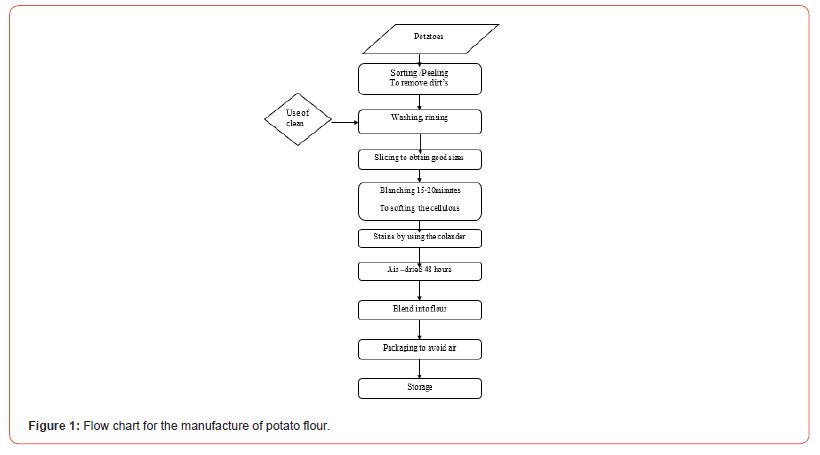
• Carrot
The carrot was bought, washed, rinse in a large basin with tap water, grate, and dried in an electrical dryer for 60-1hour, remove and ground into flour. As shown below.
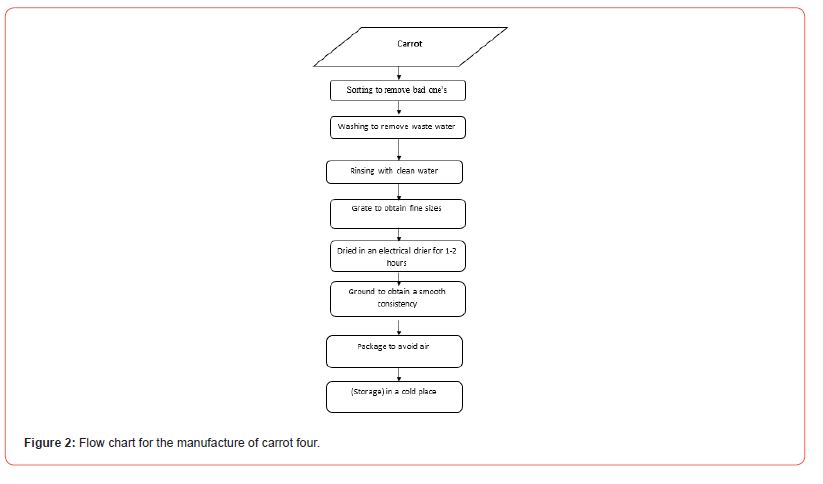
• Cassava
The cassava was bought at the Bambui market in Tubah Subdivision, washed, cleans and divided in smaller sizes, washed again, soaked in a large basin with clean water, remove squeeze and dried for 2-3 days and grand into a powder. As shown in the figure below.
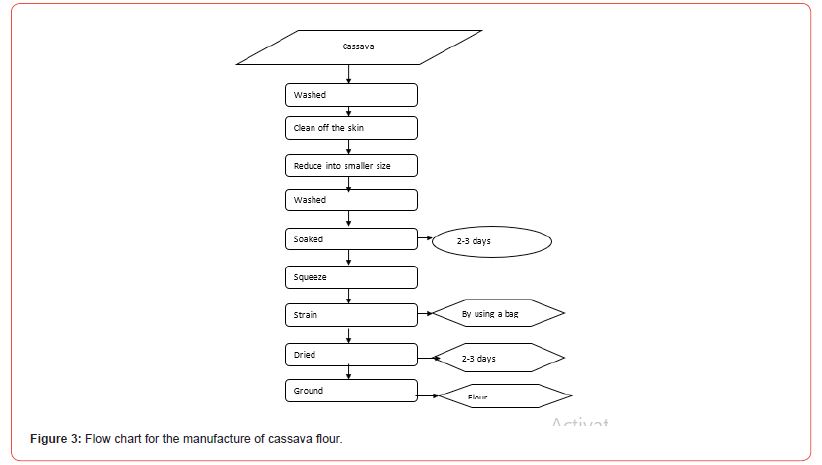
• Soya beans
The soya beans was bought from the Bambui market in Tubah Subdivision, sorted, selected, soaked for 12 hours, remove and washed by using the thumbs, boiled for 30-35minutes in order to remove the off odour, stain, air dried for 2-3days, then grand into powder. As shown below.

• Groundnut
The groundnut was bought for the Bambui market in Tubah Subdivision, sorted out and washed, strain, air dried for about 5-10 minutes, then pre –fried for 5 -10 minutes and grand into powder. As shown in the figure below.
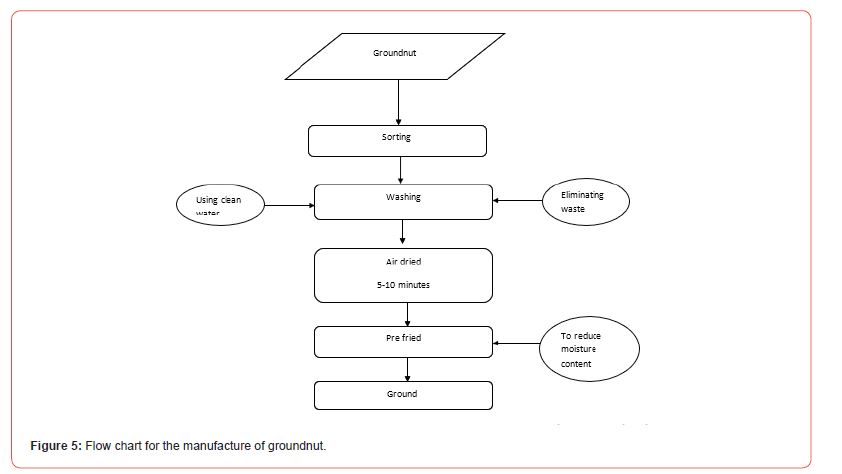
• Yellow Corn or Maize
The processing of the corn was done by selecting, soaking for two hours, straining, air dried for two to three days, pre-fried then air dried again to reduce the moisture content and ground into flour as shown below.
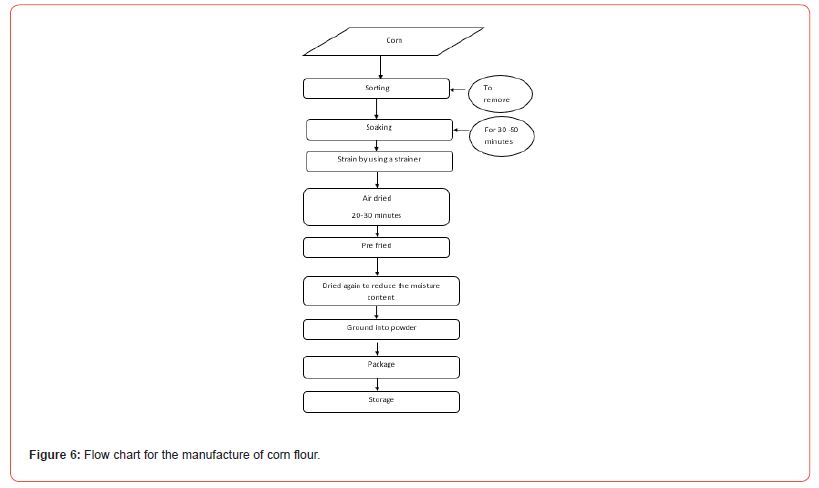
• Rice
The rice was bought at the Bambui market in Tubah Subdivision, it was selected to remove dirt’s then washed to remove dirt’s and sand, air dried for 30-40minutes, blowout dirt’s by using a tray, ground into powder and package for storage as seen in the figure below.

Sensory Evaluation of Complementary food
The two formulated complementary food were prepared into gruels and subjected to sensory evaluation to test their acceptability using a five point hedonic scale,
Where;
1 = dislike extremely; 2= dislike moderately; 3=Neither like or dislik; 4=Like moderately; 5=Like extremely.
A total of 30 pane lists were used in this study: 20 from Tubah II (adult female) 10 semi-trained panelist, the use of children care giver, these care givers were necessary because of their ability to actively evaluate the sensory characteristic of the formulations.
Chemical Analysis
Ash Content Determinations
The term ash refers to the residue left after combustion of the oven dried sample and is a measure of the total mineral content. Determination of the ash content was done according to [12]. Approximately 2.09 of each sample was weighted into different crucible. The crucible and their content were transferred into a muffle furnace set at 525Oc and allowed to stay for 1 hour. The weights of crucible and content were taken and recorded.
The percentage ash was calculated using the expression below.

Determination of Moisture
The method employed for the determination of moisture content in the sample based on the easurement of the loss in weight due to drying at a temperature of about 105Oc as describe by (AOAC, 2000). A few paper was used. About 2.09 of sample was weighted into a flue paper. The flue paper and its content were dried in an air circulated over at about 105oc to constant weight. The flue paper and its content was cooled in a desiccator desiccators and reweighted. The percentage moisture was obtained using the expression.

Determination of Crude Lipid Content
The lipid content was similary determined by the procedure described in AOAC [12]. A clean dry round bottom flask containing antibumping granules was used. Exactly 210cm3 of petroleum ether (60-80oc) was poured into the flask fitted with soxthlet extraction unit. The weighted sample was transferred into the thim ble, which was already fixed into the soxhlet extraction unit. Cold water was put on to circulate. The heating mantle was switched on and heating rate adjusted until the lovent was refluxed at a steady rate. Extraction was carried out for eight hours. The sample was removed and dried to constant weight in an oven and reweighed.

Where the weight of lipid extracted was given to be the loss in weight of the sample after extraction and drying with oven.
Determination of Crude Fibre
Crude fibre was determined by the method of [12]. Two grams of each type of grounded sample was placed in a ground bottom flask. 100ml of 0.25m H2504 was added and the mixture boiled under reflux for 30minutes. The insoluble matter was washed several times with hot water until it is acid free. Thereafter, it was transferred into a flask containing 100ml of hot 0.3m NaOH solution. The mixture was boiled again under reflux for 30minutes and filtered under suction, the insoluble residue was washed with hot water until it is base free. It was dried to constant weight in an oven at 100o cooled in a desiccator and incinerated in a furnace at 550oc for 2hours. It was put off and allowed to cool down. It was removed cooled in a desiccators and weighed (C3). The crude fibre was calculated as loss in weighed on ashing.
Weight of the original samples=W

Determination of Crude Protein
Exactly 209 of the sample was weighed into 100ml kjeldahl flask and a few antibumping granules were added. One gram of the mixed catalyst (CU504 and K2504 in the ratio 8:1 respectively) and 15ml of concentrated swphuric acid was added. The flask was placed on a kjeidahl digestion rack and heated until a clear solution was obtained. At the end of digestion the flask was cooled and the sample was quantitatively transferred to 100ml volumentric flask and made up to the mark with distilled water.
10ml of the digest was pipette into markhom semi micro nitrogen steel pipette tube. Ten millilitres (10ml) of 40% NaOH solution was added cautiously. The sample was steam distilled liberating ammonia into a 100ml conical flask containing 10ml of 4% boric acid and a drop of methyl blue indicator until colour changed from pink to green. Thirty millilitres (30ml) volume of sample was collected. The content of the conical flask was titrated with 0.1m HCL. The end point was indicated by a colour change from green to pink and the volume (v) of the acid for each distillate was noted. Percentage nitrogen per sample was calculated using the expression below;

Where: M= molarity of HCL;14 = atomic weight of nitrogen;100 = total volume of digest ;100 = % conversion;10 = volume of digest taken;1000 = to convert to liter The crude protein was calculated as;% crude = 6.25 x %N; 6.25 is the conversion factor since it is assumed that protein contains 16% nitrogen.
Data Analysis
Results are presented as mean ± standard deviation (SD) except where otherwise stated. The ANOVA test was performed to determine the significance level between the nutrient content of the three different formulas where P < 0.05 was considered significant. These statistical analyses were carried out using the SPSS software package (IBM SPSS statistics desktop v20.0).
Results and Discussion
The result obtained from laboratory work is presented in the tables and closely followed by its analyses.
Survey of locally used foodstuffs in the Preparation of Children’s Food in Tubah Subdivision.
Figure 4.1 shows the statistic on the locally used foodstuff in the preparation of children’s food in Tubah Subdivision.
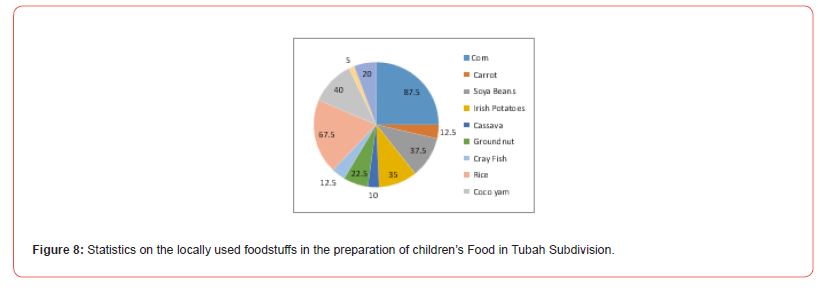
The local foodstuffs mostly used by families in this locality were used to come out with the formulas for children’s feeding. It shows that 87.5% of the population used corn, 67.5% used rice, 37.5 % used Soya beans, 35% used Irish Potatoes, 22.5% used groundnut, 12.5% used crayfish, 12.5% used Carrot, 10% used Cassava, and 5% used Beans. This variety of foodstuff was then used to formulate a more nutritive complementary food for children and a good way of preservation. This availability of many varieties could be due to the proximity of Tubah Subdivision with the Bamenda Town.
Formulations of the complementary food
Table 1: The table shows the various ways in which the three formulations F1, F2 and F3 were blended to form a nutritious and acceptable complementary food for children’s consumption.

Proximate analysis of the Various Foodstuffs Used in the Preparation of the Children’s Food in Tubah Subdivision
Table 2: Proximate analysis and results of the various samples.

As concern moisture content, corn, groundnut has the lowest moisture content 0.0009% for corn and 3% for groundnut. The highest moisture content was found in carrot 30.5%, Rice 23.76%, Soyabeans 22% and cassava 21.67%. The table indicates a low moisture content which means that corn can last for a long period of time and groundnut, except for this lipid content.
The ash content determination in the eight different samples shows that Cassava and Irish Potato is the lowest with (1±0.01 - 3±0.02), while Carrot has ash content of 8.5±0.02, soyabeans has ash content of 10±0.04 and Groundnut 13±0.4. The highest of ash content was Crayfish and Rice with (29±0.04-23.9±0.01 while the proximate composition of the formulas has it Ash content of 18.5±4.02 F2, F1 14.8±0.02 and F3 7.5±0.04. Meanwhile Corn and Groundnut also has Ash content of 14.5±0.01.
With the fiber content determination, it shows that corn has 17.30± 0.02, Cassava 16.40± 0.02, Rice 9.35± 0.02 which are the lowest. Carrot fiber content was the highest with 112.80± 0.02, Crayfish also has higher fiber content with 45.50± 0.02 potatoes has 40.50± 2.00 fiber content, Soyabeans has 59.70± 0.02 fiber content. This shows that the fiber content in Carrot is generally higher.
The lipid content in Groundnut is the highest with 53.5± 0.01, second by Carrot with 3.77± 0.03, next by Irish Potato with 29± 0.04, Crayfish with 24± 0.02. This help provide bulk in children’s food and essential amino acids. Rice has the lowest lipid content with 6.86± 0.01, while Cassava ha 6.94± 0.02 lipid content and corn 19± 0.04 lipid content.
As for the protein content, it shows that the highest is found in soya beans with 35± 0.02, Groundnut with 27.0± 0.02, Crayfish with 17± 0.01 and the lowest is found in Cassava with 1.5± 0.01, second by Carrot with 1.0± 0.02.
Where carbohydrate which is an energy given source is found more on locally available foodstuff from cereals and legumes as compared to Nestle cerelac served as children’s food.
Proximate composition of the formulas/composite and nestle cerelac
Table 3: Proximate composition of the formula/composite and nestle cerelac

Easily available and cheap commodities were used for the formulation of complementary baby food. The result presented in table 3 shows the amounts of protein provided F1, F2 and F3, this could be attributed to the positive contribution of crayfish and soyabeans to protein nutrient. Fat contents of all the 3 local formula also contributed to the essential nutrient. This is because nutrition plays a key role in children health and well being.
The approximate composition of the three local diets presented shows the results indicating that moisture, fibre, Ash, lipid and energy values (Carbohydrate) are higher in the 3-formula produced. Protein was also higher in F1. The differences in the F1, F2 and F3 can be attributed to the different qualities of the local foodstuff used inorder to get the right formula/composite. Ash content was all comparable to the value for nestle cerelac, haven shown that most of the values were higher in local cereals and legumes blends than nestle cerelac powder given to children and also the fibre cont of the nestle cerelac is higher than that of the locally blended formulas but while the locally blended cereals and legumes are higher in its formula as compare to nestle cerelac.
Sensory evaluation
The appreciation for the sensory evaluation was based on 1). Dislike extremely 2). Dislike moderately 3). Neither like or dislike 4). Like moderately 5). Like extremely. During sensory evaluation, variables controlled were been used. To care givers were selected and sealed at tables, the food was presented in a uniform fashion to them in white plastic bowls to obtain valid, reproducible results, the environment was carefully controlled, colour and lightening was control for the clear viewing of the samples while minizing distractions, the product was also controlled being of same sizes and palate cleansers were used such as plain bread, which was made to be eaten between samples to prevent carryover tastes. A rest period of at least 30 seconds was scheduled between samples. The result obtained was as follows:
Table 4: Sensory evaluation of the 3 formulas.

The table shows the mean attribute for the formulas. Taste is an important parameter when evaluating sensory attributes of food. The product might be appealing and having high energy density but without good taste, such as product is likely to be unacceptable. The mean score for formulations in term of taste was higher in F1 that is 4.8 and 4.6. Formulation of F2 was like extremely than the rest of formulated complementary foods F3 was like moderately. 4.0 in score.
Colour is an important attribute in food choice and acceptance. Outcome of sensory evaluation indicated that the samples were similar in colour F1, F2 colour was accepted by the semi trained panellists why F3 appearance was slightly different. It mean score ranges from 3.6-3.7 for F1 and F2 and F3 had a score of 3.5
Smell is an integral part of taste and general acceptance of food before it is put in the mouth. It is therefore an important parameter when testing acceptability of formulated foods. Results of sensory evaluation indicated that smell of certain samples varied significantly from the other F1 scored higher 3.9 to 4.6 in terms of smell than F2. F2 scored 4.5 and F3 4.0. Mouthfeel, the results revealed that no significant differences were observed by semitrained panelists in F1 it scored was 3.8, F2 ranked almost same 3.8 and F3 scored 3.6 by semi-trained panelist’s consistency, this study aimed at assessing maternal preferences for consistency of formulated complementary foods. In present study, semi trained panelists showed significantly higher preference for FI, F2 and F3 formulation. The favourable tastes of these samples were probably enhanced by addition of sugar and it resulted into their thin consistency.
Conclusion
At the end of the research work, it is obviously noted that the locally used foodstuffs in the preparation of the children’s food in the Tubah Subdivision are potential ingredients for formulation of cheaper and affordable nutritious and acceptable complimentary foods for children as from six (06) to 24 months.
Acknowledgment
None.
Conflict of Interest
No conflict of Interest.
References
- Prendergast A J, Humphrey J H (2014) The stunting syndrome in developing countries. Pediatrics and International Child Health 34(4): 250-265.
- UNICEF WHO World Bank Group (2020) Joint Child Malnutrition Estimates Key findings.
- UNICEF (2020) A Guidance Note for Leaving No One Behind.
- Nkeudem A G, Irene S, Ngole U, Judith A, Ning T R, et al. (2018) Nutritional Evaluation of Commonly Used Local Weaning Food Processed and Sold in the Mount Cameroon Region. 8(6): 131-141.
- Bhutta Z A, Ahmed T, Black R E, Cousens S, Dewey K, et al. (2008) What works? Interventions for maternal and child undernutrition and survival. The Lancet 371(9610): 417-440.
- Wang Y, Zhou H, Zhang Y, Huang X, Yang Y, et al. (2018) Double burden of malnutrition among children under 5 in poor areas of China. PLoS ONE 13(9): e0204142.
- Rolly M N, Michelle D F, Brice S F, Blaise K M, Borelle M, et al. (2020) The Open Nutrition Journal Cereal-based Complementary Foods Marketed in Cereal-based Complementary Foods Marketed in the City of Yaoundé: Assessment of the Compliance to Labeling and Nutritional Composition.
- AK abanda F, Hlortsi E H, Owusu-Kwarteng J (2017) Food safety knowledge, attitudes and practices of institutional food-handlers in Ghana. BMC Public Health 17(1): 1-9.
- Bedada S, Benti T, Mekonnen T (2021) Complementary Food Hygiene Practice among Mothers or Caregivers in Bale Zone, Southeast Ethiopia: A Community Based Cross-Sectional Study Shumi. Journal of Food Science and Biotechnology 1(1): 2-7.
- Dewey K G, Brown K H (2003) Update on technical issues concerning complementary feeding of young children in developing countries and implications for intervention programs. Food and Nutrition Bulletin 24(1): 5-28.
- Heiru M, Bultosa G, Bussa N (2018) Effect of Processing Methods and Blending Cereal and Legume Grain on Some Mineral and Sensory Qualities of Weaning Foods. East African Journal of Sciences 12(2): 145-152.
- AOAC (2000) The Association of Official Analytical Chemists (17th Edn). Association of Analytical Communities.
-
Difo Voukang Harouna*, Yonas Vandi and Nyuindebe Meme Caris. Formulation and Evaluation of Complementary Foods for Children from Six to Twenty- Four Months Prepared from Potential Locally Available Foodstuffs In Tuba Sub-Division of Cameroon. 4(3): 2023. GJNFS.MS.ID.000589.
-
Complementary foods, Weaning foods, Nestle cerlac, Malnutrition, Diarrhea disease, Protein, Breast feeding, Nitrogen
-

This work is licensed under a Creative Commons Attribution-NonCommercial 4.0 International License.






